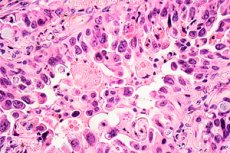
Researchers from University College London (UCL), the Francis Crick Institute and AstraZeneca have discovered the reason why targeted treatments for non-small cell lung cancer do not work for some patients, especially those who have never smoked.
Research published in Nature Communications shows that lung cancer cells with two specific genetic mutations are more likely to double their genomic load, which helps them survive treatment and develop cancer. Its stability.
In the UK, lung cancer is the third most common type of cancer and the leading cause of cancer deaths. About 85% of lung cancer patients have non-small cell lung cancer (NSCLC), and it is the most common type in patients who have never smoked. Considered separately, lung cancer in “never smokers” is the fifth leading cause of cancer death worldwide.
The most common genetic mutation found in NSCLC is in the epidermal growth receptor (EGFR) gene, which allows cancer cells to grow faster. It is found in approximately 10–15% of NSCLC cases in the UK, especially in patients who have never smoked.
Survival depends on the stage of the cancer, and only about a third of patients with stage IV NSCLC and an EGFR mutation survive three years.
Lung cancer treatments targeting this mutation, known as EGFR inhibitors, have been available for more than 15 years. However, while some patients' cancer tumors shrink when using EGFR inhibitors, other patients, especially those who have an additional mutation in the p53 gene (which plays a role in tumor suppression), do not respond to treatment and have much worse survival rates. But scientists and clinicians still could not explain why this happens.
To find the answer, researchers reanalyzed data from trials of the newest EGFR inhibitor, osimertinib, developed by AstraZeneca. They looked at baseline scans and the first follow-up scans performed after several months of treatment in patients with an EGFR mutation or with an EGFR and p53 mutation.
The team compared each tumor in scans, much larger than what was measured in the original study. They found that in patients with only EGFR mutations, all tumors shrank in response to treatment. But in patients with both mutations, while some tumors shrank, others grew larger, providing evidence of rapid resistance to the drug. This type of response, where some but not all areas of cancer shrink in response to drug treatment within a single patient, is known as a "mixed response" and poses a challenge for oncologists caring for patients with cancer.
To investigate why some tumors in these patients were more susceptible to drug resistance, the team then studied a mouse model with both EGFR and p53 mutations. They found that inside the resistant tumors in these mice, many more cancer cells had doubled their genomic load, giving them extra copies of all their chromosomes.
The researchers then treated lung cancer cells in the laboratory, some with only one EGFR mutation and others with both mutations, with an EGFR inhibitor. They found that after five weeks of exposure to the drug, a significantly higher percentage of cells with the double mutation and double genomic load had expanded into new cells that were resistant to the drug.
Professor Charles Swanton, from University College London and the Francis Crick Institute, said: "We have shown why having a p53 mutation is associated with worse survival in patients with non-smoking-related lung cancer, which is a combination of EGFR and p53 mutations allowing genome duplication This increases the risk of developing drug-resistant cells through chromosome instability."
Patients with non-small cell lung cancer are already tested for EGFR and p53 mutations, but there is currently no standard test to detect the presence of whole-genome duplications. Researchers are already looking at ways to develop a diagnostic test for clinical use.
Dr Crispin Highley, from University College London and consultant oncologist at University Hospital London, said: "Once we can identify patients with EGFR and p53 mutations whose tumors display whole genome duplications, we will be able to treat these patients more selectively. This could mean more intensive surveillance, early radiotherapy or ablation to target resistant tumors, or early use of combinations of EGFR inhibitors such as osimertinib with other drugs, including chemotherapy."

